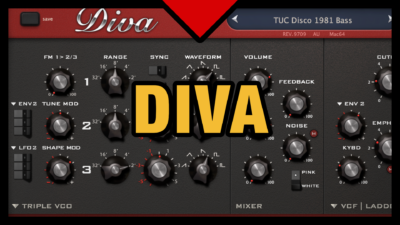 My Review of Diva
My Review of Diva
The sound of analog synthesizers, like all vintage analog gear, will never go out of style. Why? Because analog is the essence of how the world works, nature, and life itself.
No digitized waveforms, but rather waves of sound without limits. Yet they add that tiny musical imperfection and variation over time, just like the human voice.
Check out Diva here and Learn More.
Top 7 Things about Diva
Let me share my top 7 favorite things about Diva.
1. The Pure Analog Focus
The pure focus on that vintage analog sound and character. With all the variation over time, all random/human aspects of analog, drifting etc. It makes this synth amazing for basses, pulses, arpeggios, ostinatos, leads and so on.
2. The Module Approach
You can change the oscillator module from the classic MiniMoog emulation, to several other styles of analog synths. And you can do the same for the filter section, and the envelopes. This makes Diva not only one analog synthesizer, but a custom synth design of your choice.
3. Classic vs Modern
I love that you get the classic layout, and easily recognizable elements of an analog synth. But in a user interface that is scalable, modern and sleek. It makes it both fun and inspiring to dial in your own custom sounds.
4. The Deep Pages
In the bottom of the interface you can go deeper in your sound design with the various pages, such as modifications (modulation), and my favorite which is the trimmers page. In the trimmers page you can create custom variation per note. You can also access detune per voice, voice drift, and a stacking unison mode.
5. The FX Modules
You get 2 effect modules, with a couple of different effect types. At first glance this does not seem like much, but the more I used these, the more I fell in love with how quick I got the results I wanted. Especially the delay module become a personal favorite of mine.
6. The Preset Browser
Not only do you get a lot of presets, but they are very neatly organized in a big preset browser, with main sound types, tags etc. And you can also use third party preset packs, or perhaps create your own sound design preset folders. Not only that, but I love the fact that they include an init patch for all the modeled synthesizers, located in the “templates” folder.
7. The Sound Design Power
Diva is all about analog sound, but also about fast workflow. One amazing aspect of this is that you an assign a modulation parameter super quickly on a lot of various synth parameters, just by left clicking and choosing one. You can also lock any parameter, which means that it will remain locked even when you change presets.
How I personally use Diva
For me, the true power of analog synthesizers are in the amazing low end register, the fat filters, and the quick and easy to use envelopes. Also the randomness between notes, and variation over time, due to the analog aspect. This is why I love using Diva for basses, pulses, as well as riff and motif sounds. And even though it comes with a great preset library, I love how easy it is to change a few parameters to dial in my own custom sound in just a few seconds.
